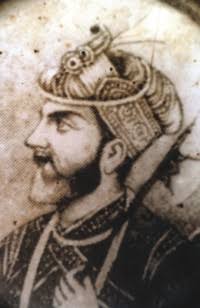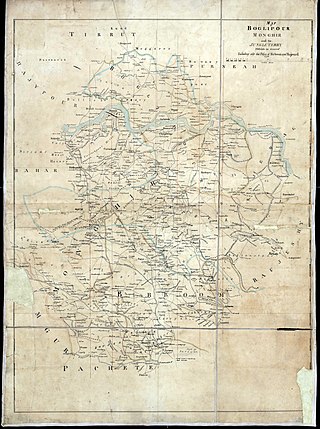Related Research Articles

A zamindar in the Indian subcontinent was an autonomous or semi-autonomous feudal ruler of a zamindari. The term itself came into use during the reign of Mughals, Marathas and later the British had begun using it as a native synonym for "estate". The term means landowner in Persian. They were typically hereditary, and held the right to collect tax on behalf of imperial courts or for military purposes.

Sher Shah Suri, often called the "Just King", was the founder of the Sur Empire in India. He was the regent and later sole ruler of Bihar from 1529—1540 until he defeated the Mughal Empire in 1540, founding the Sur Empire, and establishing his rule in Delhi, crowning himself as Emperor. After his accidental death in 1545 CE, his son Islam Shah became his successor. The influence of his innovations and reforms extended far beyond his brief reign. In his reign, he remained undefeated in battle, being renowned as one of the most skillful Afghan generals ever produced.

Isa Khan was the leader of the 16th-century Baro-Bhuiyan chieftains of Bengal. During his reign, he successfully unified the chieftains of Bengal and resisted the Mughal invasion of Bengal. It was only after his death that the region fell totally under Mughal control. He remains an iconic figure throughout West Bengal and Bangladesh as a symbol of his rebellious spirit and unity.

Muhammad Bairam Khan, commonly known as Bairam Khan or Bayram Khan was an important military commander, and later commander-in-chief of the Mughal army, a powerful statesman and regent at the court of the Mughal Emperors, Humayun and Akbar. He was also the guardian, chief mentor, adviser, teacher and the most trusted ally of Akbar. Akbar honoured him as Khan-i-Khanan, which means "King of Kings". Bairam was originally called Bairam "Beg", but later became honoured as Khan. Bairam Khan was an aggressive general who was determined to restore Mughal authority in India.

The Battle of Tukaroi, also known as the Battle of Bajhaura or the Battle of Mughulmari, was fought between the Mughal Empire and the Bengal Sultanate on 3 March 1575 near the village of Tukaroi in present-day Balasore District of Odisha. It resulted in a Mughal victory and greatly weakened the Bengal Sultanate.

Mirza RajaMan Singh I was the 24th Maharaja of Amber from 1589 to 1614. He also served as the Subahdar of Bengal for three terms from 1595 to 1606 and the Subahdar of Kabul from 1585 to 1586. He served in the Imperial Mughal Army under Emperor Akbar. Man Singh fought sixty-seven important battles in Kabul, Balkh, Bukhara, Bengal and Central and Southern India. He was well versed in the battle tactics of both the Rajputs as well as the Mughals. He is commonly considered to be one of the Navaratnas, or the nine (nava) gems (ratna) of the royal court of Akbar.

Abu'l-Fath Jalal-ud-din Muhammad Akbar, popularly known as Akbar the Great, and also as Akbar I, was the third Mughal emperor, who reigned from 1556 to 1605. Akbar succeeded his father, Humayun, under a regent, Bairam Khan, who helped the young emperor expand and consolidate Mughal domains in the Indian subcontinent.

The Zamindars of Bengal were zamindars of the Bengal region of the Indian subcontinent. They governed an ancient system of land ownership.
Askaran was a sixteenth-century Rajput monarch. Though briefly Raja of Amber, for the majority of his life Askaran was the ruler of Narwar. He also had a distinguished career as a military officer under the Mughal emperor Akbar and rose high in his service. He was also the maternal grandfather of Manavati Bai, consort of Emperor Jahangir and mother of Emperor Shah Jahan.
The Karrani dynasty was founded in 1564 by Taj Khan Karrani, an ethnic Afghan from the Karlani tribe, hailing from Bangash district. It was the last dynasty to rule the Sultanate of Bengal.
Medini Rai'a.k.a.Madini Rai or Madini Rao' ruled from 1658 to 1674 in the Palamu region of Bihar, now in Jharkhand.
The Nagvanshis of Chotanagpur, also known as the Khokhra chieftaincy, was an Indian dynasty which ruled the parts of Chota Nagpur plateau region during much of ancient, medieval and modern period. Phani Mukut Rai is considered the first king of dynasty claim to be son of Pundrika Naga, a mythical Naga. Lal Chintamani Sharan Nath Shahdeo (1931–2014) was last ruling king of the dynasty, until the estate was merged to the Republic of India.

Kharagpur Raj was a prominent chieftaincy, founded in the early 16th century in Bihar situated mainly in modern-day Munger district. They were notable for being one of the few chieftaincies in Bihar to convert to Islam and many of the rulers became firm allies of the Mughal authorities. At its peak, the Kharagpur Raj encompassed parts of the modern-day districts of Munger, Bhagalpur, Jamui, Lakhisarai, Godda and Deoghar. Due to its size, the Privy Council compared it with the Kingdom of Sardinia.
Durjan Shah was a Nagvanshi king in the 17th century. He had built Navratangarh fort.

Raghunath Shah was a Nagvanshi king in the 17th century. He succeeded his father Ram Shah in 1663. His capital was at Navratangarh. He built several temples during his reign.
The Mayi were a clan of Muslim Rajputs which controlled the Narhat-Samai chieftaincy in modern-day Nawada district of Bihar.
Ram Shah was Nagvanshi king in the 17th century. He succeed his brother Durjan Shah and ruled from 1640 to 1663 CE. Earlier their capital was at Khukhragarh, but later they shifted to Navratangarh. He was brother of king Durjan Shah.

The Subah of Lahore was a province of the Mughal Empire encompassing the central Punjab region, now divided between Pakistan and India. It was created as one of the original 12 Subahs of the Mughal Empire under the administrative reforms carried by emperor Akbar in 1580. The province ceased to exist after the death of its last viceroy, Adina Beg in 1758, with large parts being incorporated into Durrani Empire.
Puran Mal was king of Gidhaur in the 16th century. He was contemporary of Mughal Emperor Akbar. According to legend, he restored Baidyanath Temple of Deoghar.
Raja Sangram Singh was ruler of Kharagpur Raj in the 16th century. He was a contemporary of Akbar. Sangram Singh initially was allegiance to Akbar, but during the reign of Jahangir, he declared himself independence and was killed during battle with Mughal forces due to assassination. After his death, his son Toral Mal converting to Islam, changed his name to Roz Afzun, became loyal of Mughal and deployed as king of Kharagpur by Jahangir.
References
- ↑ JHARKHAND SAMAGRA (Prabhat Prakashan). Prabhat Prakashan. 2020. p. 21. ISBN 978-9390101160 . Retrieved 6 April 2022.
- ↑ "The Nagbanshis And The Cheros". archive.org. 1969.
- ↑ Ansari, Tahir Hussain (20 June 2019). Mughal Administration and the Zamindars of Bihar. Routledge. ISBN 9781000651522.
- ↑ "Mughal Administration and the Zamindars of Bihar". dokumen.pub.